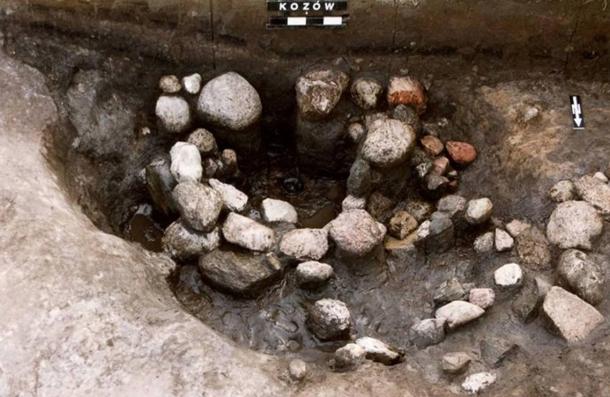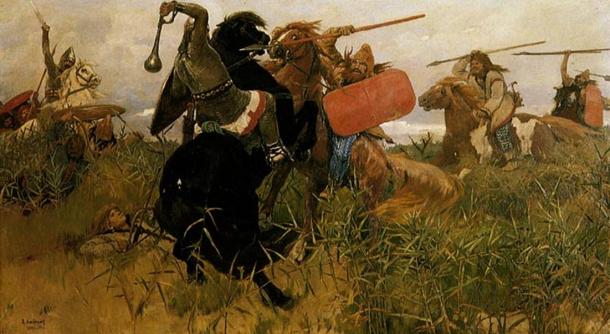A farmer made an amazing discovery more than 130 years ago in a field outside Vettersfelde (now Witaszkowo) Poland. He stumbled upon a great hoard of golden treasure, including dozens of ornaments dating back to the sixth century. But the precise location of the cache was forgotten and unknown to archaeologists until modern excavations revealed the site of the Vettersfelde Treasure.
 |
| golden object made up of four disks, each decorated with animals around a central boss, and a smaller central disk. It might have been part of a breast plate or a harness. |
In 1882 the rich artifacts found by chance in the Province of Brandenburg were collected, and some now reside in Staatliche Museen’s Antikensammlung (Collection of Classical Antiquities) in Berlin. Archaeologists had been searching for the exact source of the discovery since World War II. However, it wasn’t until 2001 that investigations narrowed down and finally uncovered the exact location.
Above: Iron sword and sheath; the scabbard and the sword's hilt and pommel are covered with sheet electrum. The shape of the sword is unmistakably that of an akinakes, the typical Scythian sword. The lower half of the sheath, now lost, had an ornamental band of soldered gold wire, braided and beaded, that bordered double spirals;below this band was a pendent row of leaf-shaped loops. The upper part of the sheath is divided into four areas. The top has a nose and two cut-out eyes; the rounded bulge is decorated with a lion and a star rosette; the long narrow part is divided by a ridge into two fields; above, a leopard pursuing a boar, followed by a fish; below, a lion attacking a fallow deer, again followed by a fish. These animals resemble those on the big fish very closely.
As reported by Science and Scholarship in Poland (PAP), the hoard of animal-themed artifacts are presumed to be Scythian. The treasure weighed nearly 5 kilograms (11 pounds) and was comprised of many items, including; a fish-shaped plaque depicting a panther, board, lion, and deer; a dagger sheath detailed with fish, vultures and deer; animal-decorated golden discs thought to be part of a breast plate; pendants and jewelry; and a massive golden torc.
The Scythians were a nomadic people of Iranian descent who migrated from central Asia into southern Russia and eastern Europe. They founded a powerful empire in the region of what is now Crimea, and were well known for their skills in battle and their horsemanship.
The joint study in Witaszkowo, held by several research and archaeological institutions and headed by by Professor Zbigniew Kobyliński and Dr. Louis Daniel Nebelsick, found success in the long search.
“By analyzing archival documents preserved in Berlin museums and field work, archaeologists identified the original place of the treasure discovery. It is a field situated between the present villages Witaszkowo and Kozów,” reveals PAP.

Gold Scythian pectoral, or neckpiece, from a royal kurgan in Tolstaya Mogila, Ordzhonikidze, Ukraine, dated to the second half of the 4th century BC. The central lower tier shows three horses, each being torn apart by two griffins.
It is thought by researchers that the treasure represents items belonging to Scythian leaders who were killed while fighting the local people of the Lusatian culture, reports archaeology news site Past Horizons. However, the discovery of the hoard spurred a long scholarly debate as to why the artifacts were buried at the site, and by whom.
Excavations at the site revealed a ceremonial spring which was lined with stones. The surrounding area was topped with paving stones and a burnt area. The remains of a wooden bridge were also discovered.
 |
| Ceremonial spring discovered during the excavations near Witaszkowo, Poland. Credit: Z. Kobyliński |
Hundreds of bowls with omphalos (or navel-shaped indentations at the bottom) were found at the spring. They are said to be similar to ancient Greek ritual drinking vessels, of a type only found in Poland as funerary goods. The bowls were said to be filled with liquids and poured out as sacrifice to gods, and metallographic analysis of the gold artifacts showed they had been in fire, but were not used as everyday items.
 |
| Ancient Greek golden phiale, or vessel with omphalos seen in the center. |
Archaeologists also recovered unique glass beads, thought to have been crafted on the Black Sea.
Kobyliński and colleagues have published the results of their research in the book ‘Finding and contextualizing of the Vettersfelde / Witaszkowo Hoard’.
In the publication, the researchers theorize that the Scythians offered the treasure to local chiefs as gifts. It is their belief that the gifts were diplomatic offerings: “the Scythians not only destroyed and looted, but also tried to secure control of long trade routes by establishing good relations with the local population,” writes Past Horizons.
Kobyliński says, “This discovery allowed us to reject previously prevailing belief that the Witaszkowo [Vettersfelde] Treasure was the spoils of war captured by the local population during battle with Scythians invaders, or a Scythian chieftain’s grave.”
The steppes art typical of the Scythians was intricate and decorative, and composed of gold, wood, silver, bronze, iron, leather and bone. Motifs were often very detailed animal and human figures. Pieces were kept light and portable to suit their largely nomadic lifestyles. Elaborate hoards of goods have been found at burial mounds and ceremonial sites across Central Asia, southern Russia and Europe, now including the Vettersfelde Treasure in Poland.
 |
 |
| Scythian gold plaque with panther, probably for a shield or breast-plate, circa end 7th-century BC. |
A successful conclusion to this enduring archaeological mystery is no doubt gratifying to the researchers and to those who appreciate learning more about the artisans, warriors and traders of the ancient past.
Reposted from Ancient Origins
Featured Image: Scythian Golden Fish from the Treasure of Vettersfelde circa 500 B.C. Altes Museum, Berlin, Germany. © Staatliche Museen zu Berlin, Antikensammlung / Johannes Laurentius; CC NC-BY-SA












